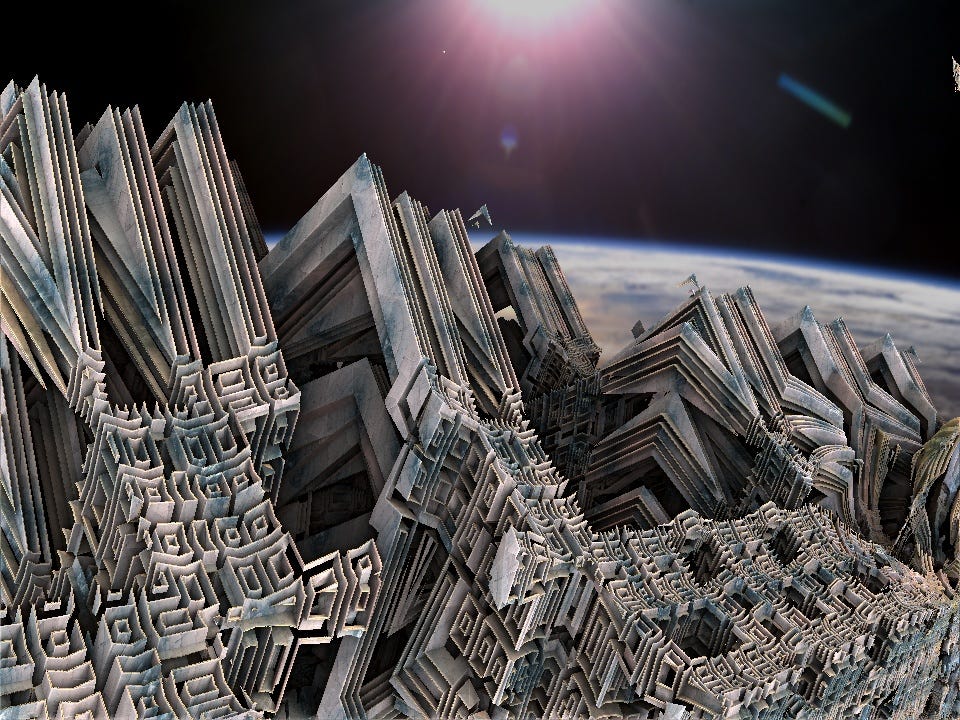Space Art
For a few years now, I've worked at creating fun and somewhat-realistic space art through various digital media. It's not only a means to an end for me, the author, to have unique art for the covers of science fiction books and to sell to cover art clients, but it's another way to tell stories. For me, at least, the most compelling and attractive art tells a story, pulls you into the frame and a new world to explore, with the potential for more if you use your imagination, than what you see in the snapshot captured by an artist.

"Stern Chase"
elements created in Mandelbulb 3D, Apophysis 7X, and Photoshop come together in a cohesive story. The stories I see in my art are usually... well, let me put it this way. In writing, I want to be as close as possible to my characters, and bring my readers along with me. I want them to be immersed in seeing, smelling, tasting the story as it plays out, to be able to envision the character on a personal emotional level. Space art, on the other hand, tends to be very much 'at arms length' due to the implied distances. In a single frame, you can imply entire planets, solar systems, galaxies... the range and sweep of it is breathtaking. And yes, you could introduce a character into that. I've done it, a time or two, with figures dwarfed by the bulk of a space station or some such. However, unless you are looking closely - and definitely not if you are looking at my art on the screen of a smart phone - you might miss that personal figment of the tale.

"Zygotes"
A imagined nursery of androids. Android figures are stock elements purchased, combined with Apophysis 7X elements in Photoshop for the complete image. So, at least for me, space art is more about allowing the imagination free reign. The stories are presented inside the vast carrier of space itself, inside the shells of ships, stations, obscured by scale on the surface of mysterious and weird planets. The viewer can weave from the implied to their own ends... it's like buying skeins of yarn and knowing all the possibilities of what you can make from these threads. Story starters, if you will. And that's why I indulge in creating space art. I could buy it - heck, I can get it free - but then I'm using something anyone else can use, which is the last thing I want on my book covers. Even stock space ships (my weakest point as an artist) I have bought to use as elements I now see frequently on covers - implying they are all existing in a shared universe!

As I've been expanding my skills, I find I love the old-school retro rocket style of space ship when I am creating space art to make myself happy.
"Planet and Ship"
Apophysis elements, and painting in Photoshop. Besides that, digital art is one of those lovely things I can manage in a few minutes at a time, creating elements that I can sit down when I have a free hour and stick together into a cohesive whole that looks amazing without messing up my desk. It's certainly not effortless, but if you put the time into learning what programs will do, then you look for tutorials, you can manage pretty awesome stuff even if you can barely manage a stick figure on paper. Thank goodness! My traditional media style is completely unsuited for book covers, unless and until I start writing children's picture books.

I've always been a sucker for exploding space ships, anyway.

Why just have an exploding spaceship when you can blow up the whole damn solar system?

"Carrier"
MB3D and Photoshop

"Bones of the Planet"
Space art lends itself well to the surreal. At least I like to take it there...

"Dawn on Station" This is one piece created wholly in MB3D, which I will probably come back to later and add in elements. But the matte background added sufficient setting to turn this fractal into what I wanted simply with some judicious tweaking.

Being able to add reflections, fog, and matte backgrounds can bring work like "Steampunk World" to life for me.

"Interstellar Trade" Available as a metal print, 8x10, as all of these are. Also for cover art in most cases, inquire for more details.




